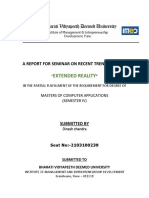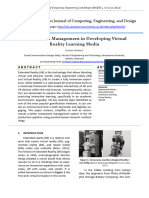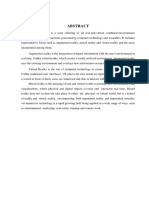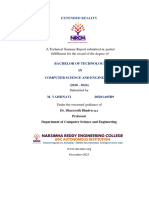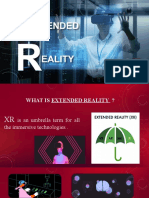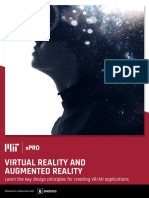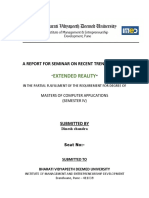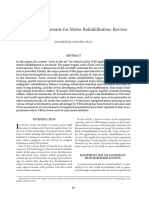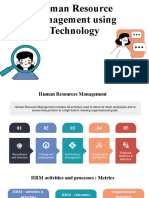Phishing Attack Prevention Using AI
Uploaded by
anushakumar8671Phishing Attack Prevention Using AI
Uploaded by
anushakumar867121IS81 NextGen Mobile Realities - Using XR
CHAPTER 1
INTRODUCTION
1.1 Overview
Extended Reality (XR) represents a convergence of immersive technologies including Augmented Reality
(AR), Virtual Reality (VR), and Mixed Reality (MR). These technologies aim to enhance or completely
transform user perception by integrating digital information with the physical world. While AR adds layers
of digital content to the physical environment, VR immerses users in a completely digital space, and MR
blends both to allow real-time interaction between real and virtual objects. The rapid advancement of XR
is redefining user engagement across multiple domains, particularly with the growing capabilities of mobile
devices.
The emergence of powerful mobile processors, high-resolution displays, and advanced sensors like LiDAR,
accelerometers, and depth cameras has enabled smartphones to handle demanding XR applications. With
5G technology significantly reducing latency and increasing bandwidth, mobile XR is now more viable and
responsive, offering real-time interaction and high-quality visuals even on compact devices. These
technological enablers are fueling the adoption of XR across sectors such as education, healthcare, gaming,
retail, and industrial design.
In educational settings, XR provides students with immersive learning environments, allowing them to
visualize abstract concepts like anatomy, astronomy, and chemistry through interactive simulations. In
healthcare, AR aids in surgery, diagnostics, and medical training, offering real-time overlays of anatomical
structures. Retail companies are using AR to enhance customer experience through virtual try-ons and 3D
product visualization. Similarly, VR is transforming gaming and entertainment by offering deeply engaging
and emotionally resonant experiences.
From a technical standpoint, XR on mobile devices relies on complex software ecosystems, including
development kits like ARKit (Apple), ARCore (Google), and Unity or Unreal Engine for 3D rendering.
These tools provide developers with the ability to create spatially aware, interactive environments that
respond to user inputs, gestures, and surroundings. Furthermore, the integration of artificial intelligence
improves object recognition, scene understanding, and user interaction in mobile XR applications.
As mobile XR grows, challenges like battery life, heat, privacy, and content standards arise. Yet, innovation
continues with AR glasses, haptics, and AI-driven XR. These advances are shaping mobile devices into
portals for immersive, intelligent digital experiences.
Department of ISE, GSSSIETW Page 1
21IS81 NextGen Mobile Realities - Using XR
1.2 Objectives
• To develop immersive and interactive mobile experiences using XR technologies such as AR, VR,
and MR, enabling users to engage with digital content in real-world contexts.
• To leverage advancements in mobile hardware, 5G connectivity, and edge computing for
delivering scalable, low-latency, and high-performance XR applications across various industries.
• To design intuitive, user-friendly, and ergonomically sound XR interfaces that enhance usability
and accessibility across different mobile devices.
• To enable remote training, assistance, and collaboration through AR and VR, reducing physical
presence requirements and improving operational efficiency.
• To utilize spatial computing and real-time environment mapping for smarter decision-making in
areas like navigation, maintenance, and industrial design.
• To ensure secure, ethical, and privacy-conscious deployment of XR technologies, addressing data
protection and responsible use in mobile immersive environments.
1.3. Evolution
The evolution of mobile technology—from analog voice systems to intelligent, high-speed digital
platforms—has played a crucial role in enabling the development and expansion of Extended Reality (XR),
which encompasses Augmented Reality (AR), Virtual Reality (VR), and Mixed Reality (MR).
First Generation (1G) networks, introduced in the 1980s, marked the beginning of mobile communication,
offering basic analog voice calls. Although revolutionary at the time, these systems lacked the data
capabilities and processing support required for immersive technologies like XR.
With the advent of Second Generation (2G) in the 1990s, mobile communication moved to digital
transmission. This allowed for services like SMS and better spectral efficiency. While 2G brought
improvements in security and mobility, XR was still impractical due to limited bandwidth and device
capabilities.
The introduction of Third Generation (3G) in the early 2000s provided a breakthrough for mobile data.
Faster internet access, multimedia messaging, and early smartphone adoption created the foundation for
simple AR applications. Users began to experience marker-based AR through mobile cameras, although
performance and realism were still limited.
Department of ISE, GSSSIETW Page 2
21IS81 NextGen Mobile Realities - Using XR
The shift to Fourth Generation (4G) significantly accelerated XR's viability on mobile devices. High-
speed data, low latency, and better graphics processing on smartphones enabled smoother and more
interactive XR experiences. This era saw the emergence of mainstream AR applications, such as Pokémon
Go, and the early adoption of mobile VR with platforms like Google Cardboard and Samsung Gear VR.
Fifth Generation (5G) represents a transformative leap for XR. It delivers ultra-low latency, high
bandwidth, and supports edge computing—all of which are critical for real-time XR processing. This allows
for cloud-rendered XR content, multi-user immersive experiences, and seamless integration of AI for
spatial awareness and interaction. With 5G, mobile devices become powerful XR platforms capable of
supporting applications in education, healthcare, industry, and entertainment.
As mobile technology continues to evolve, so too does XR, with the next frontier involving AI integration,
lightweight AR wearables, and spatial computing. This synergy between mobile network evolution and
XR innovation is shaping the future of immersive mobile experiences, making XR more accessible,
intelligent, and transformative than ever before.
Department of ISE, GSSSIETW Page 3
21IS81 NextGen Mobile Realities - Using XR
CHAPTER 2
RELATED WORK
2.1 Literature survey
This literature survey delves into the progression of Extended Reality (XR) technologies and their
integration with mobile platforms. It encompasses significant research contributions from 2019 to 2025,
emphasizing developments in hardware, software, applications, and user experiences.
[1] Baichuan Zeng, "Recent Advances and Future Directions in Extended Reality (XR): Exploring
AI-Powered Spatial Intelligence," arXiv:2504.15970, 2025.
This paper provides an in-depth overview of how AI techniques, especially computer vision and spatial
understanding algorithms, are enhancing XR experiences. It discusses the integration of spatial intelligence
for scene reconstruction, real-time environment mapping, and human-object interaction in virtual and
augmented spaces. Future directions highlighted include emotion-aware XR systems, multimodal sensor
fusion, and personalized digital environments powered by machine learning. It also emphasizes the
importance of real-time AI inferencing for latency-sensitive XR applications
[2] Shuqing Li et al., "XRZoo: A Large-Scale and Versatile Dataset of Extended Reality (XR)
Applications," arXiv:2412.06759, 2024.
This dataset-oriented study introduces XRZoo, which contains over 500 XR applications and metadata
across different platforms (AR, VR, MR). It categorizes these applications by domain (e.g., education,
gaming, healthcare), interaction methods, and hardware compatibility. The dataset aids researchers in
understanding trends, evaluating performance benchmarks, and developing standardized testing protocols.
It is especially useful for comparative studies and simulation-based training of XR systems.
[3] Ruizhen Gu et al., "Software Testing for Extended Reality Applications: A Systematic Mapping
Study," arXiv:2501.08909, 2025.
The study identifies key challenges in testing XR applications, such as verifying 3D interactions, ensuring
cross-device compatibility, and handling real-time constraints. It categorizes testing strategies into model-
based, behavior-driven, and automated testing approaches. A significant insight is the need for hybrid
frameworks combining simulation and real-world testing to ensure safety and usability. The paper also
suggests tool development as a research priority for XR QA processes
Department of ISE, GSSSIETW Page 4
21IS81 NextGen Mobile Realities - Using XR
[4] Ryo Suzuki et al., "Augmented Reality and Robotics: A Survey and Taxonomy for AR-enhanced
Human-Robot Interaction and Robotic Interfaces," arXiv:2203.03254, 2022.
This comprehensive survey outlines how AR can enhance robot interfaces for industrial, medical, and
domestic use. It introduces a taxonomy covering visualization techniques, input modalities, and
collaborative strategies. Case studies include AR-assisted robotic surgery and maintenance procedures. The
authors highlight the synergy between spatial mapping technologies in AR and robotic path planning.
Challenges discussed include occlusion handling, latency, and cognitive overload in real-time collaborative
system
[5] "Towards Augmented and Mixed Reality on Future Mobile Networks," Multimedia Tools and
Applications, Springer, 2023.
This paper addresses how 5G and upcoming 6G technologies can enable ultra-low-latency and high-
bandwidth support for mobile XR. It examines mobile edge computing (MEC), network slicing, and AI-
based predictive caching as enablers for seamless AR/MR streaming. It also evaluates Quality of
Experience (QoE) metrics specific to XR, such as field of view synchronization and input-response lag.
The study forecasts a paradigm shift where computation offloading becomes standard in XR delivery
[6] "AR/VR Trends and Predictions for 2025 & Beyond: Charting the Future of Digital Realities,"
STI Corporate, 2024.
This article provides an industry-focused forecast, predicting widespread adoption of XR in remote work,
telemedicine, and consumer gaming. It discusses advancements in lightweight wearable devices, eye-
tracking, and spatial audio. Major players like Apple, Meta, and Google are projected to lead innovation.
One key prediction is the convergence of XR and AI to enable adaptive, context-aware virtual
environments. Ethical considerations such as digital addiction and data privacy are also addressed
[7] "Android XR: Everything You Need to Know," Android Central, 2025.
This technical guide details the Android ecosystem’s support for XR through platforms like ARCore and
Android OpenXR. It explores developer tools, device compatibility, and APIs for environment
understanding, motion tracking, and cloud anchors. Key challenges include fragmentation in Android
hardware and ensuring consistent user experience across devices. The article is particularly useful for
developers looking to build cross-platform XR apps within the Android framework
[8] "The Tech to Build the Holodeck," The Verge, 2025.
This speculative but technically grounded article describes how current XR, AI, and haptics technologies
are converging toward creating immersive environments akin to Star Trek’s Holodeck. It reviews the role
Department of ISE, GSSSIETW Page 5
21IS81 NextGen Mobile Realities - Using XR
of volumetric displays, spatial audio, full-body tracking, and intelligent virtual agents. Though complete
realization is decades away, partial implementations using CAVE systems and room-scale VR setups are
already in research labs. It serves as an aspirational blueprint for immersive spatial computing
[9] "Role of AR, VR, and MR in Reshaping the Healthcare Industry," Softqubes, 2024.
This paper focuses on how XR technologies are transforming diagnosis, therapy, and training in medicine.
Applications include AR-assisted surgeries, VR exposure therapy, and MR-based anatomy training. It
underscores the benefits of reduced procedural time, improved accuracy, and better patient engagement. It
also notes the growing regulatory scrutiny around medical XR and the need for FDA-compliant
development standards. Wearable medical XR devices are forecast to see major investment through 2030
[10] "Mobile Augmented Reality Market Size & Share 2025–2030," 360iResearch, 2024.
This market research report projects significant growth in mobile AR, driven by consumer demand,
enterprise use, and increasing smartphone penetration. The report segments the market by application (e.g.,
retail, gaming, education), region, and platform (iOS, Android). It attributes growth to factors such as 5G
rollout, increased AR SDK capabilities, and improved battery and GPU efficiency in mobile devices. The
report also identifies key vendors and funding trends in mobile XR startups
Department of ISE, GSSSIETW Page 6
21IS81 NextGen Mobile Realities - Using XR
CHAPTER 3
METHODOLOGY
The methodology for implementing NextGen Mobile Realities using Extended Reality (XR) involves a
layered architecture that seamlessly integrates input systems, data processing, rendering, and user feedback.
The overall goal is to deliver immersive, real-time, and context-aware XR experiences on mobile platforms.
This process includes the following stages:
1. Input Devices
These are hardware components that collect real-world data and contextual information.
• Sensors (accelerometers, gyroscopes, ambient light sensors) to track movement and orientation.
• Cameras for environmental mapping and facial/gesture recognition.
• GPS and IMUs for location-based services and spatial awareness.
Capture real-time data from the user’s environment, which serves as the foundation for XR interaction.
2. Data Processing Layer
Once data is captured, it is processed locally or remotely to support real-time XR interactions.
• Edge computing ensures low-latency processing on the device.
• Cloud integration handles large-scale processing, offloading complex tasks.
• AI algorithms analyze visual data, speech inputs, and spatial mapping to produce intelligent
outputs.
This layer interprets raw sensor inputs and converts them into actionable data that can be rendered in the
XR space.
3. XR Content Generation
This stage focuses on creating immersive content based on processed input data.
• 3D rendering engines (e.g., Unity, Unreal Engine) for spatial visuals.
• Spatial audio and haptic feedback modules for multi-sensory experiences.
• Object overlays, digital twins, virtual assistants are generated in real time.
Department of ISE, GSSSIETW Page 7
21IS81 NextGen Mobile Realities - Using XR
Enables dynamic creation of augmented/virtual content in response to real-world inputs.
4. Output Devices
Processed XR content is delivered to users through various mobile-compatible devices.
• AR Glasses (e.g., HoloLens, Magic Leap)
• Smartphones and Tablets for AR overlays
• Head-Mounted Displays (HMDs) like Oculus Quest for immersive VR
Serve as the display interfaces for users to experience and interact with XR content.
5. User Interaction & Feedback
User interactions are captured and used to adapt and enhance the experience in real time.
• Gesture tracking, eye-tracking, and voice commands allow intuitive interaction.
• Feedback loops via AI enable the system to learn user behavior and optimize responses.
Closes the feedback loop, enabling continuous interaction and system refinement.
Department of ISE, GSSSIETW Page 8
21IS81 NextGen Mobile Realities - Using XR
3.1 Flow chart
Figure 3.1: Flowchart of NextGen Mobile Realities-Using XR
• Start: Initiation of the XR system.
• Input Devices: Collection of real-world data through sensors, cameras, GPS, and IMUs.
• Data Sufficiency Check:
• Yes: Proceed to Data Processing Layer.
• No: Feedback loop to Input Devices for additional data collection.
• Data Processing Layer: Processing of collected data using AI algorithms, edge computing, and
cloud integration.
• XR Content Generation: Creation of immersive content through 3D rendering, audio synthesis,
and haptic feedback.
• Output Devices: Delivery of XR content via AR glasses, smartphones, and head-mounted displays
(HMDs).
• User Interaction & Feedback: User engagement through gestures, voice commands, and eye-
tracking, with feedback loops to refine the experience.
• End: Completion of the XR session
Department of ISE, GSSSIETW Page 9
21IS81 NextGen Mobile Realities - Using XR
3.2 Algorithm
• Tracking Algorithm – Visual Inertial Odometry (VIO)
Used in: ARCore (Android), ARKit (iOS), many XR apps
Combines camera input and motion sensor data to track the device’s position and orientation in
real time, enabling stable and accurate AR experiences.
• Computer Vision – Object & Surface Detection
Used in: Maintenance AR apps
Identifies flat surfaces and real-world objects using the camera, allowing digital content to be
anchored accurately in the environment.
• Spatial Mapping – SLAM (Simultaneous Localization and Mapping)
Used in: AR glasses, XR2 chip systems
Builds a 3D map of the surroundings while tracking device movement, enabling persistent AR
where virtual objects stay in place.
• Rendering Algorithm – Real-Time Lighting and Shading
Used in: Unity/Unreal XR apps
Simulates realistic lighting, shadows, and reflections on virtual objects to make them blend
naturally into the real world.
Department of ISE, GSSSIETW Page 10
21IS81 NextGen Mobile Realities - Using XR
CHAPTER 4
APPLICATIONS
4.1 Applications of Extended Reality (XR) in Mobile Realities
Extended Reality (XR), encompassing Augmented Reality (AR), Virtual Reality (VR), and Mixed Reality
(MR), has found powerful real-world applications, especially when integrated into mobile platforms. These
applications span diverse sectors, redefining how we interact with information, environments, and each
other through real-time immersion and context-aware experiences.
• Healthcare:
➢ XR enables remote surgeries, AR-assisted diagnostics, and immersive medical training simulations.
➢ AR overlays patient data on real-world anatomy, aiding in minimally invasive procedures.
➢ VR is used for mental health therapy, including PTSD and anxiety management.
• Education & Training:
➢ AR apps turn smartphones into interactive learning tools, overlaying educational content in the real
world.
➢ VR simulations enable risk-free training environments for industries like aviation, medicine, and
manufacturing.
➢ Mixed Reality enhances collaborative learning experiences with spatial interactivity.
• Manufacturing & Maintenance:
➢ Technicians use AR headsets or smartphones to visualize complex machinery with overlays for
repair instructions.
➢ XR reduces downtime by offering real-time guided maintenance and troubleshooting.
➢ Digital twins and virtual prototyping improve design accuracy and testing speed.
• Retail & E-commerce:
➢ AR lets customers preview furniture, clothing, or cosmetics in real-time before purchase.
➢ Virtual fitting rooms and try-before-you-buy features increase engagement and reduce return rates.
➢ XR-enabled navigation in stores improves the customer experience.
Department of ISE, GSSSIETW Page 11
21IS81 NextGen Mobile Realities - Using XR
• Real Estate & Architecture:
➢ XR allows clients to walk through virtual buildings or properties before construction.
➢ AR apps project 3D models of architectural layouts directly on real land plots.
➢ Enhances design presentations with immersive spatial visualization.
• Entertainment & Gaming:
➢ Mobile XR powers immersive gaming experiences using real-world environments as a game
canvas.
➢ Location-based AR games (e.g., Pokémon GO) merge physical and virtual worlds.
➢ XR is transforming storytelling through 360° videos, interactive AR series, and VR concerts.
4.2 Case Studies
Case Study 4.2.1: AR Navigation in Urban Mobility – Google Live View
Challenges:
• Conventional GPS interfaces can be confusing in complex environments like cities or malls.
• Difficulty in real-time, on-ground orientation using 2D maps.
Solutions:
• Google’s Live View uses ARCore on Android and ARKit on iOS to project real-time directions
over the real world via smartphone cameras.
• Combines VIO (Visual Inertial Odometry), GPS, and SLAM for precise location tracking and
surface recognition.
Results:
• Enhanced user experience with intuitive, visual navigation.
• Reduced confusion in high-density areas like airports or downtown streets.
• Increased safety as users spend less time looking down at maps.
Case Study 4.2.2: XR in Remote Industrial Training – PTC’s Vuforia Chalk
Challenges:
• Skilled technicians cannot always be physically present to guide or troubleshoot.
Department of ISE, GSSSIETW Page 12
21IS81 NextGen Mobile Realities - Using XR
• High travel costs and downtime during machine repair or setup.
Solutions:
• Vuforia Chalk combines live video sharing with AR annotations over mobile devices.
• Allows remote experts to draw and highlight directly on a technician’s view.
Results:
• Reduced equipment downtime by enabling real-time expert assistance.
• Improved training and knowledge transfer without requiring physical presence.
• Widely adopted in industries such as aerospace and manufacturing.
Case Study 4.2.3: Virtual Shopping Experience – IKEA Place App
Challenges:
• Customers find it difficult to visualize furniture size and aesthetics in their own homes.
• High rate of returns due to mismatch in expectations.
Solutions:
• IKEA Place uses ARKit to let users place true-to-scale furniture in their physical environment using
a smartphone.
• Enables movement, lighting adjustments, and multiple item placement to simulate real settings.
Results:
• Increased user confidence in online purchases.
• Decrease in product return rate due to better visual accuracy.
• Enhanced engagement and interaction in the shopping process.
Department of ISE, GSSSIETW Page 13
21IS81 NextGen Mobile Realities - Using XR
CHAPTER 5
ADVANTAGES AND DISADVANTAGES
5.1 Advantages
Extended Reality (XR) offers transformative benefits when implemented through mobile devices,
bridging the digital and physical worlds in real time. As smartphone processing capabilities grow and
sensors improve, mobile XR becomes more accessible, cost-effective, and scalable across industries
such as education, healthcare, real estate, and entertainment.Multi-Modality Handling: GPT-4 can
process and generate text, images, and code, enabling agents to interact with diverse data formats and
interfaces.
• Immersive Anywhere Access: XR enables users to experience virtual environments or augmented
content directly on mobile phones, removing the need for bulky gear.
• On-the-Go Learning: AR overlays can provide real-time guidance or educational content,
enhancing hands-on learning and training.
• Cost-Efficient Solutions: Mobile XR applications are cheaper to deploy compared to headset-based
XR systems, utilizing widely available smartphones.
• Context-Aware Interactions: XR apps use sensors and GPS to deliver location-based content, such
as AR navigation or virtual guides.
• Improved Customer Engagement: XR allows customers to try products virtually (e.g., clothing,
furniture), increasing satisfaction and sales.
• Wider Reach Across Devices: Apps built on platforms like ARCore and ARKit run on many
smartphones, making XR accessible to a broad audience.
• Remote Assistance and Collaboration: Mobile AR apps allow professionals to offer live guidance
with real-time visuals and annotations.
• Next-Level Entertainment: XR enhances games, movies, and social media with interactive
elements, creating immersive user experiences.
5.2 Disadvantages
Despite its rapid growth and versatility, mobile-based XR faces several limitations. These challenges stem
from hardware constraints, privacy concerns, and immature development ecosystems. Additionally, the
real-world deployment of XR must address ethical, physical, and psychological considerations for long-
term sustainability.
Department of ISE, GSSSIETW Page 14
21IS81 NextGen Mobile Realities - Using XR
• Hardware Constraints: Mobile devices have limited processing power and battery life, restricting
high-end XR performance.
• User Health Risks: Extended XR use can lead to eye strain, motion sickness, or distraction in
unsafe environments.
• Data Privacy Concerns: XR apps require access to personal data like camera feed and location,
raising security and surveillance risks.
• Fragmented Device Support: Not all smartphones support advanced XR features, leading to
inconsistent app performance.
• High Development Costs: Creating high-quality mobile XR applications requires significant
investment in design and development resources.
• Connectivity Challenges: Real-time XR needs fast internet and low latency, which may not be
available everywhere.
• Limited Physical Feedback: Mobile XR lacks haptic feedback found in dedicated VR devices,
reducing realism in simulations.
• Ethical and Psychological Issues: Overuse or poor implementation of XR can affect mental well-
being and blur the line between reality and simulation.
5.3 Recent Developments in NextGen Mobile Realities Using XR
Recent developments in XR (Extended Reality) technologies are redefining how humans interact with
mobile devices and digital environments. With the fusion of AR (Augmented Reality), VR (Virtual
Reality), MR (Mixed Reality), and AI, mobile XR experiences are becoming more immersive, context-
aware, and intelligent.
• Improved Visual-Inertial Tracking: Advanced tracking systems like Visual Inertial Odometry
(VIO) in ARKit and ARCore combine camera feeds and motion sensors to achieve highly accurate
real-time tracking of mobile device movement.
• AI-Driven Object & Scene Understanding: Computer vision models now allow XR apps to
recognize real-world surfaces and objects, enabling seamless placement of digital elements. This is
crucial for AR games, retail previews, and medical applications.
• High-Fidelity Rendering with Real-Time Lighting: XR rendering engines such as Unity and
Unreal Engine now support dynamic lighting, reflections, and shadows, which enhance the realism
of virtual objects when viewed on mobile screens or headsets.
Department of ISE, GSSSIETW Page 15
21IS81 NextGen Mobile Realities - Using XR
• On-Device SLAM Integration: Simultaneous Localization and Mapping (SLAM) algorithms are
now embedded directly into XR chips (e.g., Snapdragon XR2), enabling low-latency spatial
mapping without cloud dependence.
• Cross-Platform Interoperability: New frameworks support cross-device XR experiences (e.g.,
Meta Quest ↔ smartphone ↔ PC), allowing users to continue a session across platforms or
collaborate remotely in shared XR spaces.
The Future of NextGen XR-Based Mobile Realities: Looking forward, XR will evolve from novelty to
necessity in mobile technology, redefining how users engage with data, entertainment, education, and the
physical world.
• Fully Immersive Mobile Interfaces: Future mobile devices may project full virtual environments
or integrate directly with wearables like AR glasses, replacing flat screens with 3D interfaces.
• Spatial Commerce & XR Payments: Augmented shopping will become standard, with users trying
products in 3D before purchase, and completing transactions through gesture-based or voice-
activated interfaces in XR.
• Hyper-Personalized Experiences: XR apps will adapt in real-time to user preferences and
behaviors, supported by contextual AI that delivers tailored content based on environment, history,
and intent.
• AI + XR Hybrid Agents: Personal assistants will be visually embodied in XR, guiding users
through tasks, learning environments, or city navigation using real-time spatial data and AI
decision-making.
• Standardization & Ethical Design: As XR becomes more immersive, regulatory standards will
evolve for accessibility, privacy, and user well-being in digital environments. Developers will be
expected to design ethically responsible XR content.
5.4 Enhancements in NextGen Mobile Realities Using XR
Next-generation mobile XR technologies have seen significant enhancements, making them more
immersive, responsive, and integrated into everyday experiences. These improvements are shaping how
users interact with the digital world through mobile devices and wearables.
• Advanced Spatial Mapping & Environmental Understanding: Modern XR platforms now
feature enhanced spatial awareness through LiDAR sensors, depth cameras, and AI-driven scene
recognition. This allows mobile XR systems to map environments more precisely, enabling realistic
placement and interaction with virtual elements in real-world contexts.
Department of ISE, GSSSIETW Page 16
21IS81 NextGen Mobile Realities - Using XR
• Real-Time Gesture and Voice Interaction: The integration of computer vision and NLP has
improved XR interfaces. Users can now control applications through natural hand gestures or voice
commands, enabling hands-free, intuitive interaction—especially useful in gaming, training, and
AR navigation.
• Collaborative XR Workspaces: XR systems have evolved to support multi-user environments
where people can interact with the same digital space from different devices. These shared virtual
or augmented spaces are increasingly used in remote education, virtual meetings, and collaborative
design.
• Improved Display and Rendering Technologies: Enhancements in screen resolution (like 4K per
eye), higher frame rates, and low-latency rendering have made XR experiences smoother and more
lifelike. Mobile XR headsets and AR glasses now offer clearer visuals and better comfort for
prolonged use.
• Context-Aware Personalization: XR applications can now adapt to a user’s context—like location,
time, activity, and even mood—using sensors and machine learning. This leads to highly
personalized AR/VR content, such as fitness coaching, immersive advertising, or adaptive learning
modules.
• Edge Computing for XR: Offloading computations to edge devices has reduced latency and power
consumption in mobile XR applications. This is essential for delivering real-time interaction in
mobile AR/VR without relying on remote cloud servers, particularly in environments with limited
connectivity.
• Cross-Reality Content Portability: With the rise of WebXR and universal engines like Unity and
Unreal, XR content can now be developed once and deployed across mobile AR, VR headsets, and
mixed reality devices. This advancement ensures a unified experience across devices and platforms.
• Continuous Learning and Adaptation in XR Systems: XR platforms are now capable of adapting
over time, learning from user interactions. For instance, AR navigation systems become more
efficient as they learn preferred routes, while XR tutors can adjust teaching methods based on
student responses.
Department of ISE, GSSSIETW Page 17
21IS81 NextGen Mobile Realities - Using XR
CONCLUSION
The exploration of NextGen Mobile Realities using XR reveals a transformative shift in how digital
interactions are evolving beyond screens into immersive, spatially aware experiences. XR technologies—
Augmented Reality (AR), Virtual Reality (VR), and Mixed Reality (MR)—are no longer limited to gaming
or entertainment but are rapidly redefining mobile productivity, education, healthcare, engineering, and
more. By enabling real-time data visualization, remote collaboration, and intuitive human-computer
interaction, mobile XR is paving the way for more dynamic and intelligent workflows.
As hardware becomes more compact and powerful, and connectivity through 5G and edge computing
improves, XR on mobile devices will become more accessible and integral to daily operations. These
immersive technologies promise to make information more tangible, training more effective, and decision-
making more context-aware. However, realizing the full potential of XR requires addressing challenges
related to user privacy, interface standardization, device ergonomics, and content optimization.
In conclusion, NextGen Mobile XR stands as a cornerstone of future digital transformation. Its ability to
blend the physical and digital worlds promises not only greater efficiency and engagement but also a
reimagining of how humans interact with technology. As XR continues to evolve, it will play a pivotal role
in shaping smarter, more immersive, and highly mobile realities across all sectors of society.
Department of ISE, GSSSIETW Page 18
21IS81 NextGen Mobile Realities - Using XR
REFERENCES
[1] Recent Advances and Future Directions in Extended Reality (XR): Exploring AI-Powered Spatial
Intelligence(Baichuan Zeng, arXiv, 2025) – Survey on AI-enhanced XR systems and spatial
understanding; lacks detailed benchmarks on mobile XR deployment.
[2] XRZoo: A Large-Scale and Versatile Dataset of Extended Reality (XR) Applications
(Shuqing Li et al., arXiv, 2024) – Introduces a dataset of XR apps for research and analysis; limited
insights into mobile-specific optimization.
[3] Software Testing for Extended Reality Applications: A Systematic Mapping Study
(Ruizhen Gu et al., IEEE Xplore, 2025) – Reviews XR testing challenges and strategies; lacks coverage
of cloud-based mobile XR solutions.
[4] Augmented Reality and Robotics: A Survey and Taxonomy for AR-Enhanced Human-Robot
Interfaces(Ryo Suzuki et al., arXiv, 2022) – Taxonomy of AR and robotics in HRI; underrepresents
mobile device integration in AR workflows.
[5] Towards Augmented and Mixed Reality on Future Mobile Networks(Springer, 2023) – Study on
5G/6G support for mobile AR/MR; minimal evaluation of latency performance on commercial
smartphones.
[6] AR/VR Trends and Predictions for 2025 & Beyond(STI Corporate, 2024) – Industry forecast on XR
technologies; lacks peer-reviewed technical validation.
[7] Android XR: Everything You Need to Know(Android Central, 2025) – Overview of Android XR
platform features; focuses on software tools, not hardware-performance benchmarks.
[8] The Tech to Build the Holodeck(The Verge, 2025) – Popular science article discussing XR’s future;
speculative in tone with limited empirical data.
[9] Role of AR, VR, and MR in Reshaping the Healthcare Industry(Softqubes, 2024) – Applied review of
XR in healthcare; lacks critical comparison between mobile and headset-based XR solutions.
[10] Mobile Augmented Reality Market Size & Share 2025–2030(360iResearch, 2024) – Market analysis
report for mobile AR; limited academic depth but useful for industry context.
Department of ISE, GSSSIETW Page 19
You might also like
- Exploring The Evolving Landscape of Extended Reality XR TechnologyNo ratings yetExploring The Evolving Landscape of Extended Reality XR Technology6 pages
- Extended Reality (XR) Environments - August 2021No ratings yetExtended Reality (XR) Environments - August 202126 pages
- Webxr Asset Management in Developing Virtual Reality Learning MediaNo ratings yetWebxr Asset Management in Developing Virtual Reality Learning Media9 pages
- Extended Reality Exploring The Immersive FutureNo ratings yetExtended Reality Exploring The Immersive Future10 pages
- Beyond The Phone: Exploring Phone-XR Integration Through Multi-View Transitions For Real-World ApplicationsNo ratings yetBeyond The Phone: Exploring Phone-XR Integration Through Multi-View Transitions For Real-World Applications11 pages
- Stream 2 Exploring Market Opportunities For XR DevelopmentNo ratings yetStream 2 Exploring Market Opportunities For XR Development29 pages
- XR Skills Course: MIT xPRO VR/AR ProgramNo ratings yetXR Skills Course: MIT xPRO VR/AR Program15 pages
- 58 ST CLASS 2 AR - VR - MR - Metaverse @UPSCPiratesNo ratings yet58 ST CLASS 2 AR - VR - MR - Metaverse @UPSCPirates4 pages
- ARVR - Student - Handbook - Level1 (2) - Compressed - Organized - Organized - Organized - OrganizedNo ratings yetARVR - Student - Handbook - Level1 (2) - Compressed - Organized - Organized - Organized - Organized9 pages
- ARVR Student Handbook Level1 (2) Compressed Organized Organized Organized Organized OrganizedNo ratings yetARVR Student Handbook Level1 (2) Compressed Organized Organized Organized Organized Organized7 pages
- ARVR Student Handbook Level1 (2) Compressed Organized OrganizedNo ratings yetARVR Student Handbook Level1 (2) Compressed Organized Organized12 pages
- Module 4 - Introduction To Augmented RealityNo ratings yetModule 4 - Introduction To Augmented Reality66 pages
- Immersive Technologies in Media and EntertainmentNo ratings yetImmersive Technologies in Media and Entertainment12 pages
- Digital Technology Radar 2025 Immersive Reality VR AR XR100% (1)Digital Technology Radar 2025 Immersive Reality VR AR XR3 pages
- 2017 Book VirtualAugmentedAndMixedRealit PDFNo ratings yet2017 Book VirtualAugmentedAndMixedRealit PDF250 pages
- Augmented Reality and Virtual Reality: AuthorsNo ratings yetAugmented Reality and Virtual Reality: Authors6 pages
- CSM 4-1 - ARVR-4-1 - Mid - 2 DescriptiveNo ratings yetCSM 4-1 - ARVR-4-1 - Mid - 2 Descriptive1 page
- Haptic Technology: Paper Presentation OnNo ratings yetHaptic Technology: Paper Presentation On25 pages
- APPENDIX B: Research Instrument - SURVEY-QUESTIONNAIRE: Pupils in University of The East"No ratings yetAPPENDIX B: Research Instrument - SURVEY-QUESTIONNAIRE: Pupils in University of The East"2 pages
- Building The Metaverse: The Megadeck: 160+ Companies 7 Layers 9 Megatrends One Creator-Led Future Jon Radoff100% (2)Building The Metaverse: The Megadeck: 160+ Companies 7 Layers 9 Megatrends One Creator-Led Future Jon Radoff92 pages
- Virtual Environments For Motor Rehabilitation: Review: Maureen K. Holden, PH.DNo ratings yetVirtual Environments For Motor Rehabilitation: Review: Maureen K. Holden, PH.D33 pages
- Computer Studies Notes - Tsambe StructureNo ratings yetComputer Studies Notes - Tsambe Structure159 pages
- Group 8 - ETTA - Onboarding and RetentionNo ratings yetGroup 8 - ETTA - Onboarding and Retention17 pages









